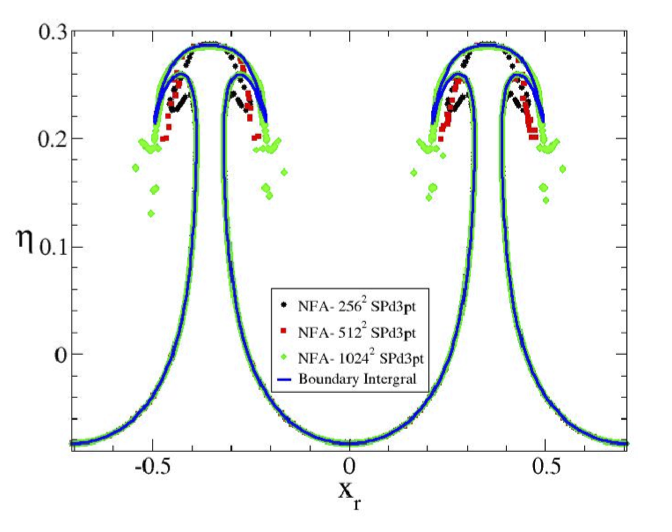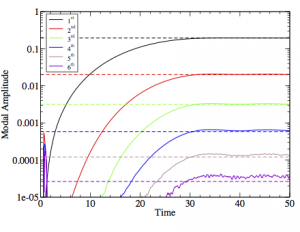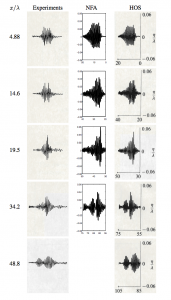Smoothing is required in two-phase Volume-of-Fluid (VOF) simulations at high Reynolds numbers to prevent tearing of the free surface due to a discontinuity in the tangential velocity between the air and the water across the free surface. The free-surface boundary layer is not resolved in VOF simulations at high Reynolds numbers with large density jumps such as air and water. Under these circumstances, the tangential velocity is discontinuous across the free-surface interface and the normal component is continuous. As a result of the discontinuity, unphysical tearing of the free surface tends to occur.
As discussed by Fu, Ratcliffe, O’Shea, Brucker, Graham, and Wyatt (2010) and Dommermuth, Fu, O’Shea, Brucker, and Wyatt (2010), Favre-like filtering can be used to alleviate this problem by forcing the air velocity at the interface to be driven by the water velocity in a physical manner. These papers are available at http://tinyurl.com/ybh4rw4w and http://tinyurl.com/yaedzwqe. The filtering is similar to using smoothing in High-Order Spectral (HOS) simulations (see Dommermuth and Yue, 1987). This type of filtering is called density-weighted velocity smoothing (DWVS) by Dommermuth.
Sussman (2003) and Sussman, Smith, Hussiani, Ohta, and Zhi-Wei (2007) use extrapolation to push the water velocity into the air. With extrapolation, there is the possibility of overshooting the velocity. Also, the tests that Sussman (2003) and Sussman, et al. (2007) perform do not consider the formation of thin jets, which is a more demanding test. However, the method is promising and deserves further investigation.
Fu, et al. (2010) discuss the use of jets formed by certain types of standing waves to test DWVS. The test is based on the studies of Longuet-Higgins and Dommermuth (2001). As Fu, et al. (2001) show, the test is easily set up in two-phase simulations of standing waves.
The test is illustrated using four different cases. An animation of the results is available at the top of this blog entry. The upper left quadrant is a 128^3 simulation with DWVS, the lower left quadrant is a 256^3 with DWVS, the upper right quadrant is a 128^3 simulation without smoothing, and the lower right quadrant is a 256^3 simulation without smoothing. The simulations without smoothing breakup over time, especially the high-resolution simulation, whereas the simulations with DWVS converge.
The figure below is from Fu, et al. (2001). The figure shows three different resolutions with DWVS to a boundary-integral method. For the highest-resolution DWVS simulation there is very good agreement with the boundary-integral method with a physical breakup at the tips of the free-surface jets where vortices are shed into the air. Details of the comparison are provided in Fu, et al. (2001).

The viscosity in DNS simulations at low Reynolds number inhibits the tearing of the free surface. Examples of DNS simulations at low Reynolds numbers include Deike, Popinet, and Melville (2015), Deike, Melville, and Popinet (2016), and Deike, Pizzo, and Melville (2017), but these approaches cannot be extended to wavelengths greater than 10 to 20cm because of limitations associated with resolving the free-surface boundary layer and severe Courant restrictions. Often DNS simulations like Deike, Melville, and Popinet (2016) use an artificially low Reynolds number to stabilize their simulations. Even with an artificially high viscosity, the tearing that is observed in some DNS simulations is probably due to poor resolution of the free-surface boundary layer and the subsequent jump in the tangential velocities.
As Dommermuth, D.G., Lewis, C.D., Tran, V.H., and Valenciano, M.A. (2014) show, simulations at high Reynolds numbers are desirable to study (1) the formation of windrows, Langmuir circulations, and wind streaks; (2) wave growth due to the effects of the wind boundary layer in the air and the drift layer in the water; (3) meandering of the cross wind and cross drift; and (4) spilling breaking waves. Dommermuth, et al. (2014) is available at http://tinyurl.com/y79sm9rp. Videos associated with Dommermuth, et al. (2014) are available at http://tinyurl.com/y8madvbw.
References:
Brucker, K. A., O’Shea, T. T., Dommermuth, D. G., and Adams, P. (2010) “Three-dimensional simulations of deep-water breaking waves,” Proceedings of the 28th Symposium on Naval Hydrodynamics, Pasadena, California, USA.
Dommermuth, D. G. and Yue, D. K. (1987) A high-order spectral method for the study of nonlinear gravity waves, J. Fluid Mech., vol. 187, 267–288.
Dommermuth, D. G., Fu, T. C., O’Shea, T. T., Brucker, K. A., and Wyatt, D. C., (2010) Numerical prediction of a seaway, Proceedings of the 28th Symposium on Naval Hydrodynamics, Pasadena, California, USA.
Dommermuth, D.G., Lewis, C.D., Tran, V.H., and Valenciano, M.A. (2014) “Simulations of wind-driven breaking ocean waves with data assimilation,” Proceedings of the 30th Symposium on Naval Hydrodynamics, Hobart, Tasmania, Australia.
Deike, L., S. Popinet, and W. Melville (2015), Capillary effects on wave breaking, J. Fluid Mech., 769, 541–569.
Deike, L., W. Melville, and S. Popinet (2016), Air entrainment and bubble statistics in breaking waves, J. Fluid Mech., 801, 91–129.
Deike, L., Pizzo, N. E., and Melville, W. K. (2017) Lagrangian transport by breaking surface waves. J. Fluid Mech. (submitted).
Fu, T.C., Ratcliffe, T., O’Shea, T.T., Brucker, K.A., Graham, R.S., Wyatt, D.C., and Dommermuth, D.G. (2010) A comparison of experimental measurements and computational predictions of a deep-v planing hull, Proceedings of the 28th Symposium on Naval Hydrodynamics, Pasadena, California, USA, 2010.
Longuet-Higgins, M. and Dommermuth, D. (2001) Vertical jets from standing waves, Proc. R. Soc. Lond., Vol. A 457, 2137–2149.
Sussman, M. (2003) A second-order coupled levelset and volume of fluid method for computing growth and collapse of vapor bubbles, J. of Comput. Phys., 187, 110–136.
Sussman, M., Smith, K.M., Hussaini, M.Y., Ohta, M., and Zhi-Wei, R. (2007) A sharp interface method for incompressible two-phase flows. J. Comput. Phys., 221, 469-505.


